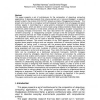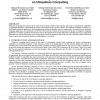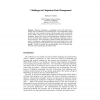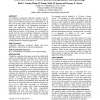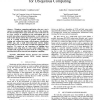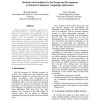WOA
2010
13 years 11 months ago
2010
Classification of users' whereabouts patterns is important for many emerging ubiquitous computing applications. Latent Dirichlet Allocation (LDA) is a powerful mechanism to e...
CACM
2005
14 years 1 months ago
2005
This paper presents a set of architectures for the composition of ubiquitous computing applications. It describes research that is being carried out in "extrovert-Gadgets&quo...
SAC
2006
ACM
14 years 1 months ago
2006
ACM
Ubiquitous computing places humans in the center of environments saturated with computing and wireless communications capabilities, yet gracefully integrated, so that technology r...
DAGSTUHL
2001
14 years 3 months ago
2001
Ubiquitous computing is a compelling vision for the future that is moving closer to realization at an accelerating pace. The combination of global wireless and wired connectivity a...
COORDINATION
2006
Springer
14 years 3 months ago
2006
Springer
Abstract. Enabling coordination among ubiquitous computing applicad resources requires programming abstractions and development tools tailored to this unique environment. This pape...
CHI
2004
ACM
14 years 7 months ago
2004
ACM
As ubiquitous computing technology migrates into the home environment, there has been a concurrent effort to allow users to build and customize such technologies to suit their own...
IPSN
2005
Springer
14 years 7 months ago
2005
Springer
— Ubiquitous computing applications often use a user's context to automatically adjust their behavior to the situation. We have developed three types of wireless sensor node...
SAC
2006
ACM
14 years 7 months ago
2006
ACM
Bringing ubiquitous computing applications to home environments is a great challenge. In our research we investigate how applications can be conceived, designed, and implemented t...
WETICE
2006
IEEE
14 years 7 months ago
2006
IEEE
Older people have been the focus of research for ubiquitous computing applications. While many of these are understandably focused on health and aging in place issues, there is al...
COMPSAC
2007
IEEE
14 years 8 months ago
2007
IEEE
Building realistic end user scenarios for ubiquitous computing applications entails large up-front investments. Many context adaptive applications so far fail to live up to their ...

